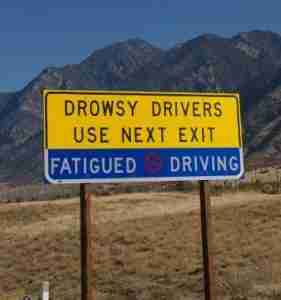 Our roads are a dangerous enough place to be. Any time spent behind the wheel of your vehicle represents a potential danger to your life for any number of valid reasons.
Our roads are a dangerous enough place to be. Any time spent behind the wheel of your vehicle represents a potential danger to your life for any number of valid reasons.
You might not be able to do anything about being in the wrong place at the wrong time, and finding yourself involved in a vehicle accident, but there are plenty of scenarios where there is often a significant contributory factor that has led to the crash happening.
The cause can be anything from a vehicle malfunction to driver error. There are a percentage of accidents that could have been avoided if you, or the other driver, had managed to get enough sleep beforehand and weren’t driving while drowsy.
A National Sleep Foundation Poll, relating to planes, trains, automobiles and sleep, sought to identify how much sleep people who operate a vehicle for a living manage to get on average, and how it affects their driving performance.
Approximately 70% of bus and truck drivers, for example, have both suggesting that sleepiness never impacts their job, but well over 10% of these respondents also reported having had a “near miss” while behind the wheel on the job.
These “near misses” aren’t recorded anywhere officially, because they haven’t resulted in an actual reportable collision or injury, but they do illustrate the perils of drowsy driving. As the report goes on to highlight, with well over half of the people surveyed claiming to have some issues with sleeping, you could argue that there are a significant number of drivers who are not as alert as they should be when in charge of a vehicle.
An estimated 100 million drivers have actually fallen asleep at the wheel if you multiply the poll results in relation to the number of vehicles on the road. About 13% of drivers doze off at least once a month while driving.
The crash statistics paint an undeniable picture
One of the major problems relating to the issue of drowsy driving is attributing an accurate figure to the crash statistics that can be blamed on driver fatigue.
The National Highway Traffic Safety Administration has attempted to put what they consider to be a conservative figure of about 100,000 police-reported crashes being caused as the result of driver fatigue, but in reality, there is no specific way to determine the true number as you can’t officially measure sleepiness in the same way that you can determine how much alcohol someone has in their blood at the time of an accident.
There are some official figures relating to accidents caused by drowsiness and fatigue but state reporting practices are not very consistent, with some states not having any official specific code to attribute drowsy driving as the cause of an accident.
The other complication that clouds this issue is that other contributory factors such as alcohol can also play a pivotal role in causing a driver to be involved in or cause an accident.
The best guess seems to be that about one million crashes each year can be put down to driver lapses, but in the United States, it is difficult to produce an official number because of reporting practices.
If you take European crash statistics, where crash reporting procedures are more consistent and defined than the U.S at this point, you can see from the evidence collated that drowsy driving is responsible for between 10% and 30% of crashes, depending on which country you look at.
Apply that same average calculation to drivers in the U.S and it would be very surprising if there was much difference in the numbers if official data was able to be accurately recorded.
What is abundantly clear is that drowsy driving represents a significant risk, both to you and fellow drivers, particularly if you get behind the wheel and start, or continue, a journey while you are feeling tired.
Identifying risk categories
When you break down the sleep-related crash statistics into different age categories you get some strong trends in terms of risks attached to certain age and gender categories.
It appears that adults who are aged between 18-29 are considered far more likely to drive while drowsy than any other age category.
From the figures available, some 71% of drivers aged between 18-29 are likely to drive while drowsy, compared with 52% of 30-64 year-olds, and 19% of drivers aged over 65 years.
You can also break down these numbers more deeply and see that 56% of men are likely to drive drowsy, in comparison to 45% of women drivers. Another significant figure of concern is the estimation that men are twice as likely to actually fall asleep while driving than women are.
Unsurprisingly, parents are more likely to drive drowsy (59%) when compared to those without children to look after.
If you are a shift worker this puts you in a higher risk category than someone who works a regular daytime schedule. An estimated 36% of shift workers are considered to be driving to or from work drowsy on at least a couple of days a month, compared to about 25% of commuters setting off at normal rush-hour times.
In simple terms, what all these numbers are basically telling us is that sleep-deprivation significantly raises the risk of sleep-related accidents. You can almost equate the number of hours someone sleeps to the level of risk they face of driving while drowsy and being involved in an accident, as there is a very close correlation.
Focusing on truck drivers
If you don’t get enough sleep or have a sleep-related disorder that is preventing you from feeling fully rested before driving a vehicle, you are putting your life and others at risk, regardless of what work you do.
It is worth highlighting truck driver fatigue as an example of how drowsy driving can become a serious problem if you are operating a vehicle for a prolonged period of time, such as being a truck driver for a living.
The Federal Motor Carrier Safety Administration (FMCSA) introduced new rules in 2011 aimed at preventing fatigued driving, creating an ‘hours of service’ framework that limited the amount of time they could spend at the wheel between designated breaks.
Some 4,000 U.S citizens die in large truck crashes each year and driver fatigue is a leading cause of this death toll. It is not just the truck drivers themselves who are driving tired of course, as they could be involved in an accident where a drowsy driver hits their vehicle and they are not at fault.
With so many annual deaths attributed to truck accidents, it makes sense that the FMCSA has sought to reduce the average number of hours driven by truck drivers each week down to 70, from a previous average of 82 before these new rules were introduced.
Truck drivers now have to take at least one 30-minute rest break within the first eight hours of their shift, and it is hoped that the long-term effect of this initiative will be to see a noticeable reduction in the number of annual truck accidents over a period of time.
Being able to identify one specific group of motorists such as truck drivers is helpful in terms of being able to target initiatives such as restricted hours between breaks, but the same common sense rules should apply to anyone who is contemplating driving a vehicle without feeling fully rested and alert for the journey ahead.
Healthy sleep
The solution for all drivers to drowsy driving is achieving regular healthy sleep.
What we know about sleep is that it is not just a period of time you spend where you are not awake, as your brain actually stays active during sleep periods and if you can get your body and mind through these various distinctive stages of a sleep pattern you have a far greater chance of waking the next morning feeling energized and rested.
The National Heart, Lung, and Blood Institute (NHLBI) carry out regular clinical trials on sleeping and can now accurately define what constitutes healthy sleep.
It is important to note that sleep needs do tend to vary between people, and your sleep needs do also tend to vary at different stages of your life, so it is not that easy to give a specific recommended number of hours of sleep each day that will work for everyone.
The average is somewhere between 7-8 hours of quality sleep per night and if you are achieving at least that amount you will be giving yourself a good chance to wake up feeling rested and with a decent level of energy.
It is very relevant to emphasize that the quality of sleep is of equal importance to the number of hours spent with your eyes closed. How much quality sleep you achieve has a direct impact on how well you be able to function the next day.
Benefits of sleep
 In the context of avoiding drowsy driving, it is clear that a healthy sleep pattern is key. It reduces the risk and prospect of not giving your driving the attention that it needs and deserves.
In the context of avoiding drowsy driving, it is clear that a healthy sleep pattern is key. It reduces the risk and prospect of not giving your driving the attention that it needs and deserves.
We need a decent amount of sleep to be able to enjoy decent reactions and think clearly when driving. For every hour of sleep that you deprive yourself of there is often a price to pay and you will often find it a bit harder to focus as well experiencing slower reaction times.
This is clearly detrimental to your driving performance overall.
When you are lacking in the right amount of sleep you are far more likely to make poor decisions and even take more risks, all of which increase your risk of being involved in a motor accident.
Sleep is beneficial to your long-term health profile and if you are regularly depriving yourself of the right amount of sleep you are potentially increasing your risk of suffering from higher blood pressure, heart problems, and a host of other medical conditions.
Achieving a good night’s sleep
It is not difficult to find plenty of evidence that confirms getting a good night’s sleep on a regular basis is going to prove beneficial and even vital to your well-being, as well as helping to reduce your risk of drowsy driving.
The simple formula to try and follow is based around sticking to a sleep schedule and pattern that involves you going to bed and waking up at the same time every day as much as possible.
Some people are more affected by others by caffeine and nicotine but it would be sensible to restrict your intake after a certain time in the day so that your body has the chance to enter a relaxed state ready for sleep.
It is also advisable to avoid consuming alcohol just before you go to bed and having a large meal or beverages late at night are all going to potentially restrict your chances of falling asleep quickly and naturally.
Try to relax before going to bed by taking a bath and distractions from TV’s, mobile phones or laptops are best avoided in the bedroom if you are going to successfully create a comfortable and restful sleeping environment.
If you try all of these tactics and still find it difficult to get the restful sleep you need to be able to function properly the next day there could be a medical reason why you are unable to achieve this aim and you might have a sleep disorder.
Dealing with a sleep disorder
As well as the obvious danger you pose to yourself and other road users, by increasing your odds of driving drowsy through lack of sleep, you will also be putting your long-term health at risk if you don’t seek help to address the problem.
There are various recognized sleep disorders and medical help is available to combat and resolve them. You will need to spot the symptoms and get the right medical advice, along with the treatment that is relevant to the specific sleep disorder.
Insomnia
Although the term insomnia is widely used to describe an inability to go to sleep, it is actually a term that is widely associated with many different sleep disorders and not a sleep disorder in itself.
Insomnia is a related symptom of other medical problems including a range of common physical and psychological issues and you can experience temporary, acute, or chronic insomnia, all characterized by an inability to fall asleep and stay asleep for any meaningful period of time.
An estimated 60 million Americans suffer from some form of insomnia and the physiological balance of your body can be seriously disrupted if the problem persists for any period of time.
Shift workers are renowned for having problems with insomnia because working at night disrupts our natural Circadian cycle.
If you are suffering from insomnia there is normally an underlying cause that needs to be identified in order to get the help you need to get you back to a meaningful sleep pattern.
Sleep apnea
Another high-profile sleeping disorder is sleep apnea and this describes symptoms where your breathing is briefly but repeatedly interrupted throughout your sleep.
Obstructive sleep apnea has the capacity to cause fragmented sleep and cause you to suffer from low blood oxygen levels, all of which significantly increases your risk of drowsy driving.
An estimated 18 million U.S citizens suffer from sleep apnea and one of the most prominent indicators of this condition is when you suffer from chronic snoring. The majority of people with sleep apnea tend to be sleep deprived and this sleeplessness produces a wide range of related symptoms such as poor concentration levels, irritability, depression, plus a tendency to fall asleep during the day, such as when you are driving a vehicle.
You should seek a professional medical opinion and help with this condition as it can get progressively worse if left untreated, putting you at risk from not just excessive sleepiness during the day, it also presents the threats of high blood pressure and heart problems.
Understanding the threat of narcolepsy
Another prominent sleep disorder is narcolepsy and recent studies have given us a greater understanding of what causes this issue and how to counteract its effect on your body.
Narcolepsy is now recognized as an autoimmune disorder where your body’s defense system is mistakenly triggered into a response, which starts out as a result of your brain’s inability to regulate periods of sleep and wakefulness.
This can have serious consequences on your ability to perform normal daily functions, like driving a car with any degree of safety, as you can be suddenly overcome with an irresistible urge to go to sleep immediately.
Federal figures estimate that about 1 in every 3,000 people suffer from this disorder. Although there is no specific cure, you can be given guidance on how to manage the symptoms and reduce the impact on your ability to function normally throughout the day.
More severe symptoms may often require medication to keep narcolepsy under control.
Restless leg leads to sleepiness

Another sleep disorder that needs to be highlighted is Restless Leg Syndrome (RLS), also sometimes referred to as Willis-Ekbom Disease.
Typical symptoms of RLS are an almost uncontrollable urge to move your legs which often gets worse when you are lying down, making it difficult to get any meaningful sleep.
Many patients who suffer from RLS report that the symptoms are often worse in the evening or during the night, which is why it is particularly difficult to achieve a good night’s sleep when you are diagnosed with this condition.
As much as 15% of the population suffer from this condition and it can be controlled and treated with a combination of some lifestyle changes and medication where required, although it is generally a lifelong condition where there is currently no known cure.
Avoiding drowsy driving
Whether you have one of these recognized sleep conditions, some other variation that is causing sleep problems, or you are simply not getting enough rest each night, these are all significant factors that can make you a danger to yourself and others behind the wheel.
Do not make the mistake of believing that fatigue is only something that affects people who drive for a living or long distances. The issue of driver fatigue is just as relevant for short-distance drivers and the fundamental issue is already being tired when you get behind the wheel.
The way we are built makes it hard for humans to fight the need to sleep once the chemicals in your brain reach a certain point and then start sending messages to your brain that trigger body to shut down.
Fatigue is actually very easy to spot if you carry out an honest evaluation of your current physical and mental condition before you set off on a journey in your vehicle.
Some the classic signs of fatigue include:
- Persistent yawning
- Feeling like your eyes are very sore or heavy
- You notice your reaction times are slower than normal
- Finding your mind wandering and not concentrating on your driving
- Erratic driving speeds that move between excessively fast and slow
- A noticeable increase in your irritation toward other drivers
- A visible deterioration in your driving performance such as sloppy gear changes
These are a few of the main pointers and warning signs that you might be driving while drowsy. The only true way of arresting the slide into sleep and beating the fatigue is to take a rest and get some sleep. Even short, fifteen-minute ‘power naps’ can make all the difference and may be enough for you to continue on with your journey.
Falling asleep for even a few seconds can have fatal consequences and the statistics consistently tell us that drowsy driving has an impact on many families each and every year.
If a medical condition or your lifestyle is preventing you from getting the sleep that you need it is advisable that you seek to find a solution that allows you to be more alert and safer the next time you get behind the wheel.
Useful resources:
https://www.fmcsa.dot.gov/safety/driver-safety/cmv-driving-tips-driver-fatigue
https://www.think.gov.uk/road-safety-laws/#fatigue
https://www.cdc.gov/features/dsdrowsydriving/index.html
https://www.cdc.gov/sleep/index.html
https://healthfinder.gov/FindServices/SearchContext.aspx?topic=797


Comments
Comments are closed.